SEO
9 Steps To A Future-Proof Social Media Strategy In A Web3 World

May I see a copy of your social media strategy?
🦗(crickets) 🦗
More than a decade into the Web 2.0 era and entering into the Web 3.0 evolution, brands are still lagging regarding a documented social media strategy.
Looking back, it was the mid to late 2000s when Facebook, Twitter, LinkedIn, YouTube, and the iPhone hit the palms of our hands.
Fast forward to today, we enter the next generation of the internet, called the metaverse, and even more digital ways to engage with audiences.
You aren’t alone if you don’t have a social media strategy.
While almost 60% of the world population are reported active social media users, more than 50% of B2C brands admit to not having documented content or social media strategy.
In addition, most brands consider themselves amateur when rating their expertise level, with more than half of brands surveyed rating their social media marketing levels as immature.
Uh oh?
It’s true! Without a strategy, you are gambling. With Web3, the metaverse, digital goods, and virtual worlds on the horizon, it is impossible to skip Web 2.0 and move on.
“I believe Web 2 and Web3 have a lot to learn from each other. There are frameworks and best practices in each which lend themselves very well to the other, so it’s a lot about bridge building. Leave behind the practices that slow us down but bring with us those which provide structure and support scaling in a sustainable way. We are moving too quickly to re-invent the wheel; better to grab the best and mold it to our future needs,” said Stefanie Hingley, COO of Mission Impact, an organization helping females elevate in Web3.
Forward-thinking, purposeful plus strategic will usually win the social media game.
Here’s a step-by-step guide to creating an effective social media strategy to level up your Web 2.0 and prepare for Web3.
1. Write An Executive Summary
Start your strategy with an executive summary.
This should be a one-pager, succinctly identifying your social media purpose and how it ties into your current business goals and objectives.
In addition, make a note of relevant testing or projections into Web3.
Establish the primary goal and specific objectives you are trying to achieve. Be sure to identify a channel focus and avoid trying to be all things to all social media platforms.
For example, if you are a B2B company, consider creating content for Linkedin and then repurposing it for other secondary channels.
Web3 Tip: Explore and research what other brands are doing with Web3. What is working? Start holding team meetings to discuss your social media strategy in the Horizons Workrooms environment.
“Horizons Workrooms works across both virtual reality and the web and is designed to improve your team’s ability to collaborate, communicate, and connect remotely through the power of VR— whether that’s getting together to brainstorm or whiteboard an idea, work on a document, hear updates from your team, hang out and socialize, or simply have better conversations that flow more naturally,” as noted in the Meta Newsroom.
Benchmark and include measurable outcomes to assure all players are defining success with the same expectations. Larger goals need granular objectives.
Example: Grow your Instagram audience by 20% by the end of the quarter.
2. Do A Social Media Audit
Keeping your friends close but your enemies closer is an intelligent way to stay ahead of the competition.
Start by conducting a social media audit of your brand’s social channels compared to two or three competitors. You can even pick a non-competing brand to use for inspiration and aspiration. Consider choosing a brand already involved in Web3 strategies.
For example, Wendys, Airbnb, Netflix, Buffer, Hubspot, and Cisco are known for their social media savviness. It’s helpful to go beyond your industry’s borders and see what’s working.
Compare types of content, engagement, frequency, audience size, visuals, video use, tone, and customer service messaging. How’s the response rate?
Other factors to compare and take note of include:
- Live streaming.
- Courses and webinars.
- Influencer marketing.
- User-generated content.
- Features such as Reels, Stories, and Frequency.
- Communities.
- AR/VR.
- 3D.
- Virtual Worlds.
- NFTs.
- Creator Coins, Tokens, or Crypto.
- Metaverse collaborations.
- Audio experiences.
- Emoji use.
- Facebook Messenger, chatbots.
- Keywords and hashtags.
- Third-party content.
- Online branded search results.
- Reviews.
According to the 2022 Social Media Marketing Industry Report, brands and marketers see increased exposure and traffic as social media’s main benefits. On the flip side, the “struggle is real” for translating social media into quantitative ROI, such as improving sales and generating leads.
Recent reports indicate Facebook and Linkedin are the go-to channels if you are looking for leads out of social media channels.
3. Zero In On Social Media Objectives
Focus Pocus.
Let’s quickly review the difference between goals, strategy, objectives, and tasks, known as GSOT.
- Goals: These are your broad social media outcomes.
- Strategy: The approach you will take to accomplish your goal.
- Objectives: These are measurable steps you will take to achieve the strategy.
- Tactics: These are the tools or tasks used in pursuing an objective related to a strategy.
Examples:
- Goal: Make our book the #1 best-seller in the Metaverse category.
- Strategy: Increase the amount of content we publish on social channels supporting the book’s topics, ideas, and opinions.
- Objective: Increase unique visitors from social channels to the book’s website or landing page by 50%.
- Tactic: Using metaverse and Web3 influencers, leverage the exposure with branded hashtags and behind-the-scenes content using Instagram Stories, Facebook Live, and Twitter.
- Advanced: Participate and host events in Web3-centric communities using Twitter Spaces, Clubhouse, Discord communities, and virtual worlds such as Meta’s Horizon Worlds, Decentraland, Roblox, or Alt Space VR.
4. Develop Buyer Personas
Know your avatar. Develop a personal relationship with your personas. If 50% of brands lack a documented social media strategy, the number of brands having defined buyer personas must be significantly greater.
Brands need personas. This is a must if you want to survive and thrive in Web3.
Marketers preach the value of personas, but when it comes down to investing the time and effort into building and using personas? Zzzzzzzz. Sound asleep.
The good news: The lack of buyer personas makes for a huge opportunity if your competition is missing the persona step.
Buyer personas + social media = a winning formula.
The results mean big wins in increased:
- Conversions.
- Relevance scores.
- Engagement.
- Efficiencies across the board.
Getting your persona started is a must!
Start with these buyer persona hacks and get to know your buyers.
#SocialPRSecret: In his book “X: The Experience When Business Meets Design,” digital analyst Brian Solis had this to say:
“You want to create personas for the people who buy from you today as well as for those who don’t, whom you’re targeting. The research that goes into the accurate portrayal of current and potential customers and their behaviors should be a combination of demographic, psychographic, and ethnographic.”
When creating your buyer personas, don’t forget to include your media, stakeholders, community admins and moderators, podcasters, bloggers, and influencers as personas.
The media (journalists, podcast hosts, Twitter Spaces hosts, Clubhouse room hosts) is your target audience, too! Make them real people with real interests and real lives. You might relate to them more.
5. Find Your Brand Persona
Every brand needs a voice, personality, and sense of character.
Think about what adjectives describe your brand.
Are you positive, fun, playful, or coy?
Maybe your brand is serious, straight-laced, and emoji-free.
Do you dare to roast or poke fun at a competition like Wendy’s and Taco Bell?
Make a list of how you want to be perceived when interacting with a brand. Are you supporting and encouraging or sensational and bold?
In 2009, when social media was heating up, best-selling author and PR icon Aliza Licht played the persona behind the famous (and now defunct) @DKNYPRGirl.
Of the experience, Licht said:
“Before any other fashion brand had stepped into the social game, I created an anonymous Twitter personality called DKNY PR GIRL. DKNY PR GIRL pioneered authentic voices in social media and ultimately captivated the attention of 1.5 million people around the world across platforms. In 2011, I revealed myself as the person behind the handle, which resulted in over 230 million global impressions, including a full-page feature in The New York Times.”
Licht’s persona behind the DKNY PR GIRL netted some nice gains for her personal brand.
“Over six years, my DKNY PR GIRL persona resulted in many awards, a TED talk, and a book deal. “Leave Your Mark” was published in 2015 and has successfully mentored thousands of professionals around the world.”
7. Establish Strategies & Tools
This is where you figure out how to slice up the paid, earned, and owned categories.
Paid social is a must – and it doesn’t have to break the bank.
Maybe the combo looks something like this:
Paid
Increase your results, and boost a featured Facebook post once a week.
According to Joe Youngblood, wait a few days before boosting a Facebook post, and let it publish organically and then boost.
Owned
Remember, anything you build on social media is basically “rented space.”
You do not own your social media community, following, or content. It can shut down tomorrow, as we saw with Vine, Blab, and other now defunct social media channels.
You can transition your social media community into an email list (this is what you own).
Think of creating some free download, cheat sheet, guide, or course to gain direct access to your audience.
Introduce a branded hashtag and start using it across social platforms. Publicize in bios and posts.
Encourage influencers to use the hashtag. Promote hashtags across social platforms, emails, ads, and social media covers and captions.
Earned
Monitor social media for branded keywords and targeted keyword phrases. Twitter is primed with journalists, bloggers, and real-time influencers. Find the conversations and engage.
Warning: This activity has been known to cause positive media coverage, shares, and engagement outcomes.
#SocialPRSecret: You can’t buy good public relations and social proof, and you can’t hide from negative PR.
Earn the positive first to own more and gain positive search and social results.
Tools
I like Canva. She likes Spark. They like Hootsuite. We like Buffer. The CEO’s son wants to know why you don’t have a Snapchat geo filter.
Having 50 million tools fragmented across your social media team is no fun and not efficient. That’s a slight exaggeration; the point is to have an approved list of tools and platforms.
Everyone needs to be using the same social media management tools and platforms.
Web3 Tip: Explore Web3-centric tools and platforms such as spacial.io, Discord, and Threedium to enhance your brand experience.
8. Make Your Mark: Timing & Dates
Timing is everything! One day late is a dollar lost.
You must show up to the party early on social media and never be late. This means researching industry dates for conferences and events. Look up tie-ins to seasons, days, or official months.
Make sure your reporting is efficient and on point for the proper analysis.
The CEO gets the one-pager, the CMO gets the two-pager, sales gets the sales connection report, and the analysts get the full 10-pager.
Match the report with the right persona and what they care about most.
Figure out internal dates, external dates, and reporting dates.
- Internal: Check out conferences, workshops, team meetings, and marketing reports in your industry. Don’t forget the hashtags!
- External: Look at seasons, themes, events, and trending news to tie into your social media content.
#SocialPRSecret: From Pineapple Day to World Productivity Day, never miss a day! Check out Days of the Year and keep your editorial calendar filled with the most interesting events, festivals, and weird holidays. And bookmark this SEJ article to help your editorial calendar further: You Need This Marketing Calendar & Free Template!
Web 3 Tip: Sign up for Crypto, Web3, and NFT-related events. Be on the lookout for virtual and in-person events and conferences to educate your team and possibly connect with Web3 partners to elevate your brand.
9. Measure What Matters
Measuring what matters is the key to social media strategy sanity and success.
Every network has its version of analytics. It’s easy to spend infinite time running reports. Make sure you are circling back to those measurable objectives.
Look at both quantitative for the hard numbers and qualitative for the sentiment and intent.
- Quantitative examples include website sessions, number of email sign-ups, impressions, and social network data.
- Qualitative examples include sentiment, such as favorable reviews or comments on social messaging. For example, did you raise prices on the menu and have complaints on your Facebook Page?
Quantitative tells what happened, and qualitative can usually tell the “why.” For instance, you have a positive feature story in Business Insider with a link to your company website, which caused a spike in website visits.
When influencers started turning on Daily Harvest, the vegan meal-delivery service that sells bowls, soups, and smoothies, with negative reviews after falling ill – this could be an example of quantitative and qualitative – sales fell, negative media publicity, and negative social media sentiment.
Conclusion
After following all of these steps, what’s next?
You might find yourself in a different direction due to your new social media strategy process.
You may venture your brand into the metaverse, start an NFT collection, continue your hashtag campaign, and even add more budget.
#SocialPRSecret: After accessing your reports and progress, create a proposed action plan, including the next steps. Provide analysis and recommendations interpreting your findings.
Web3 Tip: Make sure you are following the evolution of Web3 – the next generation of the world wide web, which includes the unfolding of the creator economy, decentralization; artificial intelligence (AI) and machine learning; Augmented Reality (AR) and Virtual Reality (VR), the metaverse, Non-Fungible Tokens (NFTs), and connectivity and ubiquity, blockchain, digital wearables, and more.
While having a documented social media strategy is important, it’s more important to make sure the plan is fluid and flexible and to keep current on trends.
Meta offers Meta Blueprint, a selection of self-paced and self-guided courses, certifications, and educational materials designed to keep your business moving forward.
As a marketer, having these certifications can help you stand out from your competition.
Keep the social in social media by staying engaged and in the conversation. The strategy will follow, flow, and fill from Web 2.0 to Web3. Be sure you are proficient in Web 2.0 to maximize your returns in Web3.
More Resources:
Featured Image: Jacob Lund/Shutterstock
SEO
Measuring Content Impact Across The Customer Journey

Understanding the impact of your content at every touchpoint of the customer journey is essential – but that’s easier said than done. From attracting potential leads to nurturing them into loyal customers, there are many touchpoints to look into.
So how do you identify and take advantage of these opportunities for growth?
Watch this on-demand webinar and learn a comprehensive approach for measuring the value of your content initiatives, so you can optimize resource allocation for maximum impact.
You’ll learn:
- Fresh methods for measuring your content’s impact.
- Fascinating insights using first-touch attribution, and how it differs from the usual last-touch perspective.
- Ways to persuade decision-makers to invest in more content by showcasing its value convincingly.
With Bill Franklin and Oliver Tani of DAC Group, we unravel the nuances of attribution modeling, emphasizing the significance of layering first-touch and last-touch attribution within your measurement strategy.
Check out these insights to help you craft compelling content tailored to each stage, using an approach rooted in first-hand experience to ensure your content resonates.
Whether you’re a seasoned marketer or new to content measurement, this webinar promises valuable insights and actionable tactics to elevate your SEO game and optimize your content initiatives for success.
View the slides below or check out the full webinar for all the details.
SEO
How to Find and Use Competitor Keywords

Competitor keywords are the keywords your rivals rank for in Google’s search results. They may rank organically or pay for Google Ads to rank in the paid results.
Knowing your competitors’ keywords is the easiest form of keyword research. If your competitors rank for or target particular keywords, it might be worth it for you to target them, too.
There is no way to see your competitors’ keywords without a tool like Ahrefs, which has a database of keywords and the sites that rank for them. As far as we know, Ahrefs has the biggest database of these keywords.
How to find all the keywords your competitor ranks for
- Go to Ahrefs’ Site Explorer
- Enter your competitor’s domain
- Go to the Organic keywords report
The report is sorted by traffic to show you the keywords sending your competitor the most visits. For example, Mailchimp gets most of its organic traffic from the keyword “mailchimp.”


Since you’re unlikely to rank for your competitor’s brand, you might want to exclude branded keywords from the report. You can do this by adding a Keyword > Doesn’t contain filter. In this example, we’ll filter out keywords containing “mailchimp” or any potential misspellings:
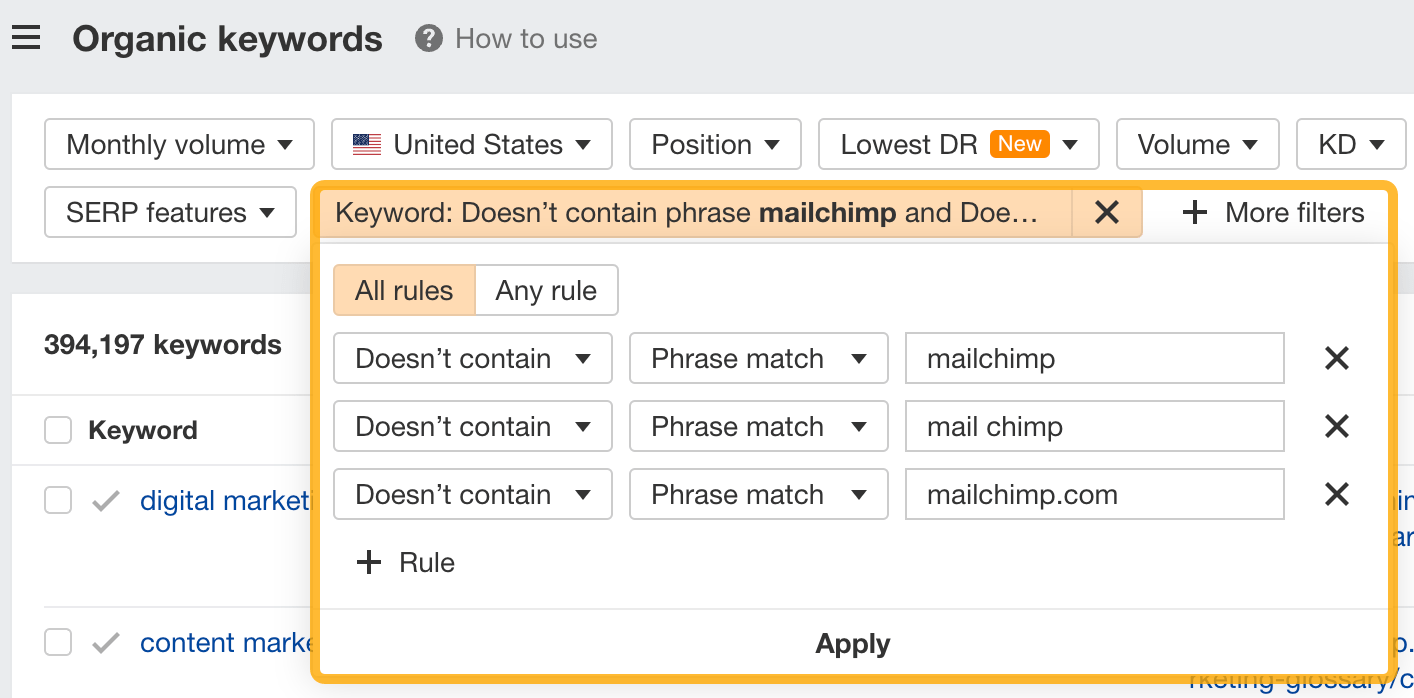

If you’re a new brand competing with one that’s established, you might also want to look for popular low-difficulty keywords. You can do this by setting the Volume filter to a minimum of 500 and the KD filter to a maximum of 10.


How to find keywords your competitor ranks for, but you don’t
- Go to Competitive Analysis
- Enter your domain in the This target doesn’t rank for section
- Enter your competitor’s domain in the But these competitors do section


Hit “Show keyword opportunities,” and you’ll see all the keywords your competitor ranks for, but you don’t.


You can also add a Volume and KD filter to find popular, low-difficulty keywords in this report.


How to find keywords multiple competitors rank for, but you don’t
- Go to Competitive Analysis
- Enter your domain in the This target doesn’t rank for section
- Enter the domains of multiple competitors in the But these competitors do section
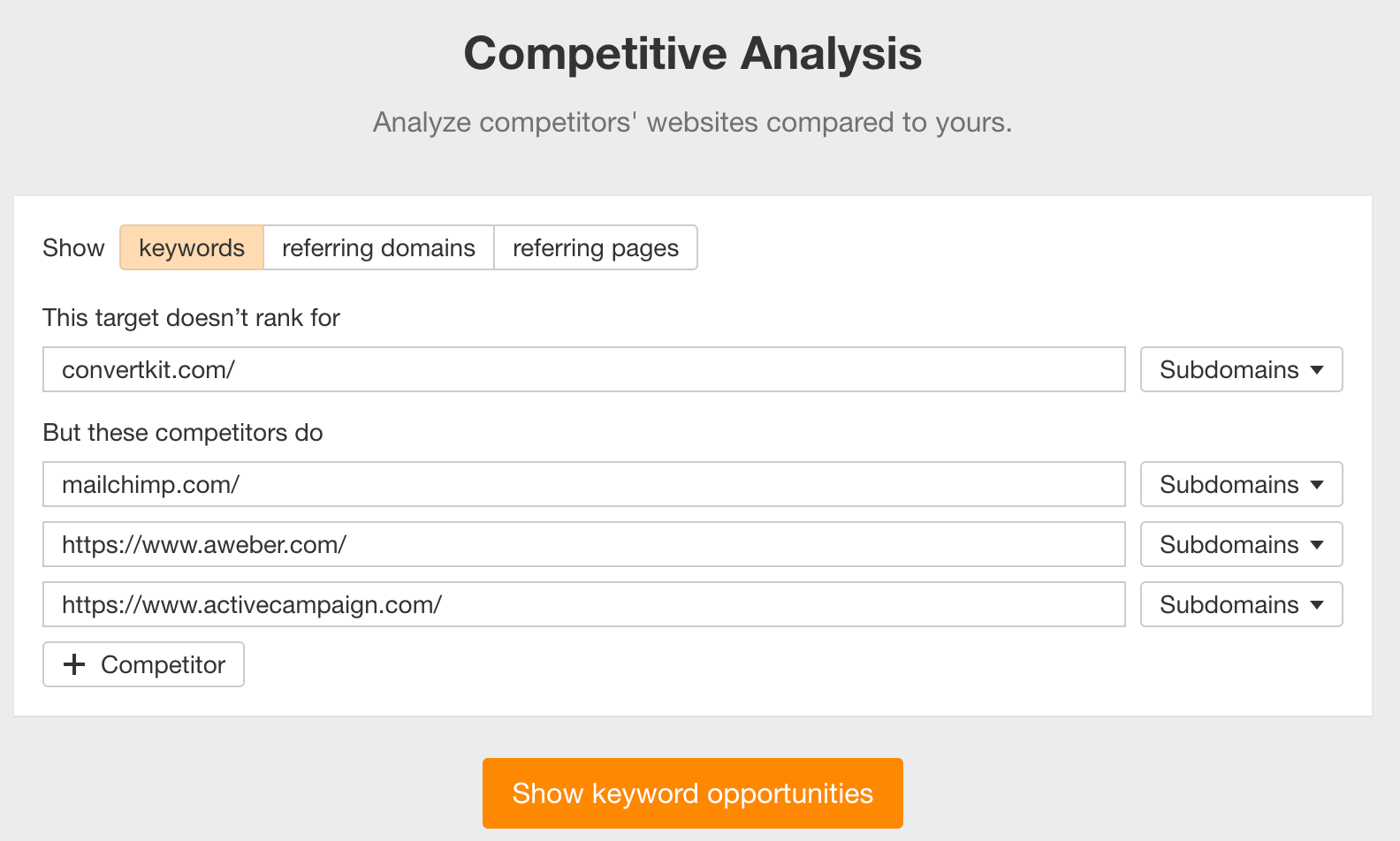

You’ll see all the keywords that at least one of these competitors ranks for, but you don’t.


You can also narrow the list down to keywords that all competitors rank for. Click on the Competitors’ positions filter and choose All 3 competitors:


- Go to Ahrefs’ Site Explorer
- Enter your competitor’s domain
- Go to the Paid keywords report


This report shows you the keywords your competitors are targeting via Google Ads.
Since your competitor is paying for traffic from these keywords, it may indicate that they’re profitable for them—and could be for you, too.
You know what keywords your competitors are ranking for or bidding on. But what do you do with them? There are basically three options.
1. Create pages to target these keywords
You can only rank for keywords if you have content about them. So, the most straightforward thing you can do for competitors’ keywords you want to rank for is to create pages to target them.
However, before you do this, it’s worth clustering your competitor’s keywords by Parent Topic. This will group keywords that mean the same or similar things so you can target them all with one page.
Here’s how to do that:
- Export your competitor’s keywords, either from the Organic Keywords or Content Gap report
- Paste them into Keywords Explorer
- Click the “Clusters by Parent Topic” tab


For example, MailChimp ranks for keywords like “what is digital marketing” and “digital marketing definition.” These and many others get clustered under the Parent Topic of “digital marketing” because people searching for them are all looking for the same thing: a definition of digital marketing. You only need to create one page to potentially rank for all these keywords.
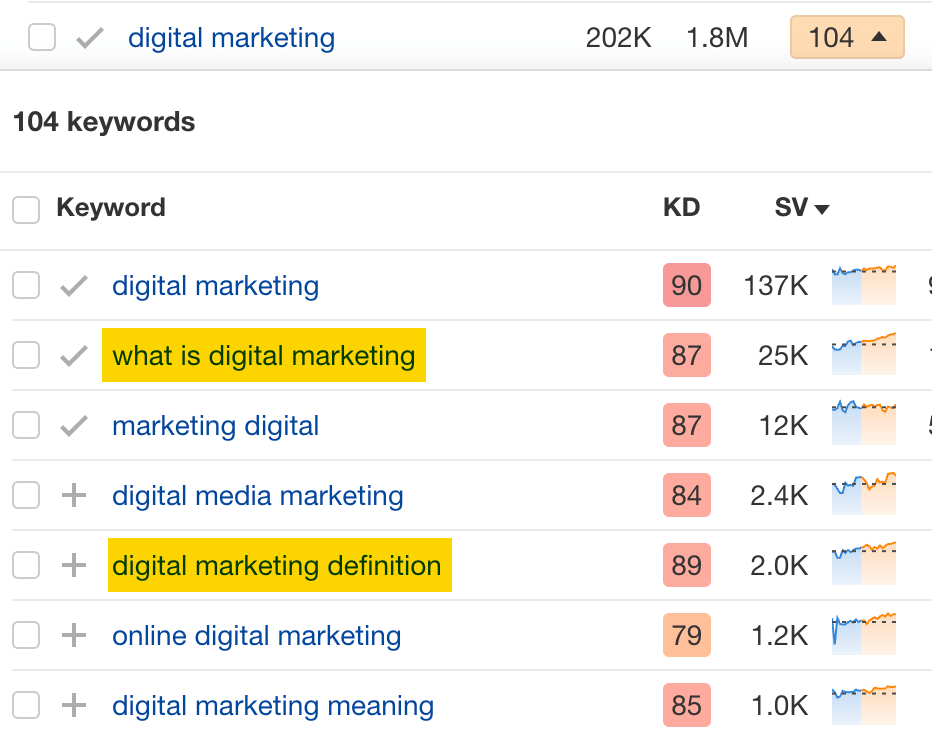

2. Optimize existing content by filling subtopics
You don’t always need to create new content to rank for competitors’ keywords. Sometimes, you can optimize the content you already have to rank for them.
How do you know which keywords you can do this for? Try this:
- Export your competitor’s keywords
- Paste them into Keywords Explorer
- Click the “Clusters by Parent Topic” tab
- Look for Parent Topics you already have content about
For example, if we analyze our competitor, we can see that seven keywords they rank for fall under the Parent Topic of “press release template.”


If we search our site, we see that we already have a page about this topic.


If we click the caret and check the keywords in the cluster, we see keywords like “press release example” and “press release format.”
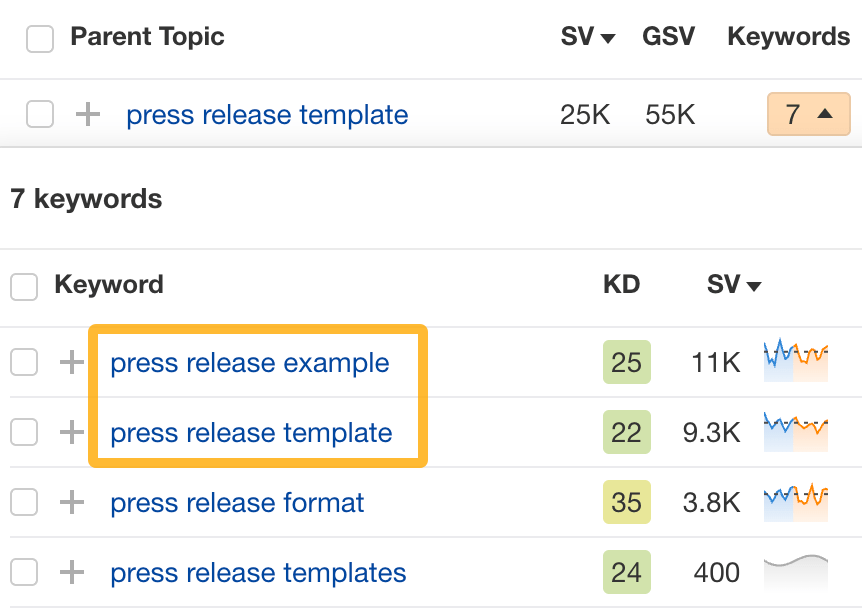

To rank for the keywords in the cluster, we can probably optimize the page we already have by adding sections about the subtopics of “press release examples” and “press release format.”
3. Target these keywords with Google Ads
Paid keywords are the simplest—look through the report and see if there are any relevant keywords you might want to target, too.
For example, Mailchimp is bidding for the keyword “how to create a newsletter.”


If you’re ConvertKit, you may also want to target this keyword since it’s relevant.
If you decide to target the same keyword via Google Ads, you can hover over the magnifying glass to see the ads your competitor is using.
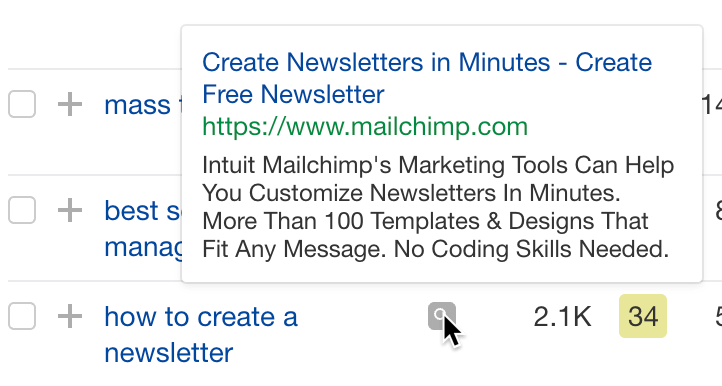

You can also see the landing page your competitor directs ad traffic to under the URL column.


Learn more
Check out more tutorials on how to do competitor keyword analysis:
SEO
Google Confirms Links Are Not That Important

Google’s Gary Illyes confirmed at a recent search marketing conference that Google needs very few links, adding to the growing body of evidence that publishers need to focus on other factors. Gary tweeted confirmation that he indeed say those words.
Background Of Links For Ranking
Links were discovered in the late 1990’s to be a good signal for search engines to use for validating how authoritative a website is and then Google discovered soon after that anchor text could be used to provide semantic signals about what a webpage was about.
One of the most important research papers was Authoritative Sources in a Hyperlinked Environment by Jon M. Kleinberg, published around 1998 (link to research paper at the end of the article). The main discovery of this research paper is that there is too many web pages and there was no objective way to filter search results for quality in order to rank web pages for a subjective idea of relevance.
The author of the research paper discovered that links could be used as an objective filter for authoritativeness.
Kleinberg wrote:
“To provide effective search methods under these conditions, one needs a way to filter, from among a huge collection of relevant pages, a small set of the most “authoritative” or ‘definitive’ ones.”
This is the most influential research paper on links because it kick-started more research on ways to use links beyond as an authority metric but as a subjective metric for relevance.
Objective is something factual. Subjective is something that’s closer to an opinion. The founders of Google discovered how to use the subjective opinions of the Internet as a relevance metric for what to rank in the search results.
What Larry Page and Sergey Brin discovered and shared in their research paper (The Anatomy of a Large-Scale Hypertextual Web Search Engine – link at end of this article) was that it was possible to harness the power of anchor text to determine the subjective opinion of relevance from actual humans. It was essentially crowdsourcing the opinions of millions of website expressed through the link structure between each webpage.
What Did Gary Illyes Say About Links In 2024?
At a recent search conference in Bulgaria, Google’s Gary Illyes made a comment about how Google doesn’t really need that many links and how Google has made links less important.
Patrick Stox tweeted about what he heard at the search conference:
” ‘We need very few links to rank pages… Over the years we’ve made links less important.’ @methode #serpconf2024″
Google’s Gary Illyes tweeted a confirmation of that statement:
“I shouldn’t have said that… I definitely shouldn’t have said that”
Why Links Matter Less
The initial state of anchor text when Google first used links for ranking purposes was absolutely non-spammy, which is why it was so useful. Hyperlinks were primarily used as a way to send traffic from one website to another website.
But by 2004 or 2005 Google was using statistical analysis to detect manipulated links, then around 2004 “powered-by” links in website footers stopped passing anchor text value, and by 2006 links close to the words “advertising” stopped passing link value, links from directories stopped passing ranking value and by 2012 Google deployed a massive link algorithm called Penguin that destroyed the rankings of likely millions of websites, many of which were using guest posting.
The link signal eventually became so bad that Google decided in 2019 to selectively use nofollow links for ranking purposes. Google’s Gary Illyes confirmed that the change to nofollow was made because of the link signal.
Google Explicitly Confirms That Links Matter Less
In 2023 Google’s Gary Illyes shared at a PubCon Austin that links were not even in the top 3 of ranking factors. Then in March 2024, coinciding with the March 2024 Core Algorithm Update, Google updated their spam policies documentation to downplay the importance of links for ranking purposes.
The documentation previously said:
“Google uses links as an important factor in determining the relevancy of web pages.”
The update to the documentation that mentioned links was updated to remove the word important.
Links are not just listed as just another factor:
“Google uses links as a factor in determining the relevancy of web pages.”
At the beginning of April Google’s John Mueller advised that there are more useful SEO activities to engage on than links.
Mueller explained:
“There are more important things for websites nowadays, and over-focusing on links will often result in you wasting your time doing things that don’t make your website better overall”
Finally, Gary Illyes explicitly said that Google needs very few links to rank webpages and confirmed it.
I shouldn’t have said that… I definitely shouldn’t have said that
— Gary 鯨理/경리 Illyes (so official, trust me) (@methode) April 19, 2024
Why Google Doesn’t Need Links
The reason why Google doesn’t need many links is likely because of the extent of AI and natural language undertanding that Google uses in their algorithms. Google must be highly confident in its algorithm to be able to explicitly say that they don’t need it.
Way back when Google implemented the nofollow into the algorithm there were many link builders who sold comment spam links who continued to lie that comment spam still worked. As someone who started link building at the very beginning of modern SEO (I was the moderator of the link building forum at the #1 SEO forum of that time), I can say with confidence that links have stopped playing much of a role in rankings beginning several years ago, which is why I stopped about five or six years ago.
Read the research papers
Authoritative Sources in a Hyperlinked Environment – Jon M. Kleinberg (PDF)
The Anatomy of a Large-Scale Hypertextual Web Search Engine
Featured Image by Shutterstock/RYO Alexandre
-

 PPC5 days ago
PPC5 days ago19 Best SEO Tools in 2024 (For Every Use Case)
-
SEARCHENGINES7 days ago
Daily Search Forum Recap: April 16, 2024
-

 SEO7 days ago
SEO7 days agoGoogle Clarifies Vacation Rental Structured Data
-

 MARKETING6 days ago
MARKETING6 days agoStreamlining Processes for Increased Efficiency and Results
-
SEARCHENGINES6 days ago
Daily Search Forum Recap: April 17, 2024
-

 SEO6 days ago
SEO6 days agoAn In-Depth Guide And Best Practices For Mobile SEO
-

 PPC6 days ago
PPC6 days ago97 Marvelous May Content Ideas for Blog Posts, Videos, & More
-

 MARKETING5 days ago
MARKETING5 days agoEcommerce evolution: Blurring the lines between B2B and B2C














You must be logged in to post a comment Login